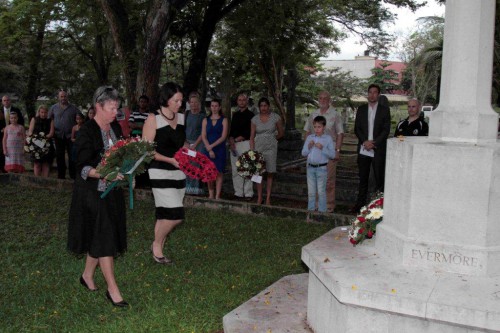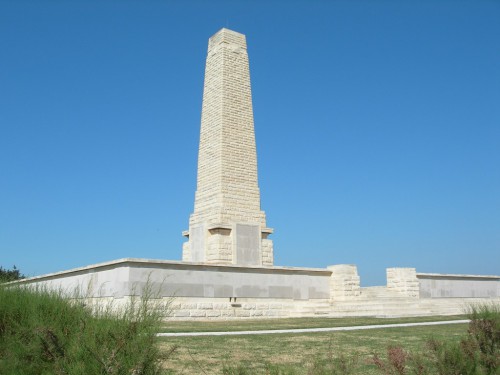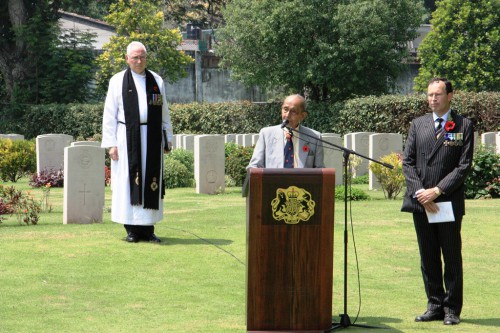28th April 2015 Colombo, Sri Lanka
100 years since Gallipoli: Ceylon’s role remembered
On Saturday 25 April, I laid a wreath at the Borella Kanatta Commonwealth War Graves Cemetery in Colombo, at one of the two events organised that day by the Australian High Commission to commemorate the 100th anniversary of the Allied landings at Gallipoli during the First World War. It was an opportunity to reflect again on the strength and breadth of the historical ties between the UK and Sri Lanka.

We didn’t just lay wreaths at the Cenotaph. We also went to the graves of three soldiers who had fought at Gallipoli but are now buried in Colombo. These young men had been injured in battle, were treated in the UK, but then died on the hospital ship taking them home. The details of their brief lives were poignant reminders of the disruption of war, and we paused to think also of the families who might never have seen where their sons were buried.
The fighting men of Ceylon also played an important role in the Gallipoli campaign, as bodyguard and escort to the General Commanding the ANZAC Corps.
The first Sri Lankan contingent to head overseas during the First World War was the Ceylon Planters Rifle Corps. This was a volunteer regiment from Kandy made up of tea and rubber planters. As early as the autumn of 1914, eight officers and 221 soldiers sailed to Egypt, and were attached to the 1st Battalion Wellington Regiment as a part of the Australia and New Zealand Army Corps (ANZAC).

In April 1915, between 80-130 troops from the Ceylon Planters Rifle Corps were attached to the 1st ANZAC Corps as a bodyguard and escort to the General Commanding the Corps, Lieutenant General William Birdwood. The Planters landed on the Gallipoli Peninsula between 25 April and 1 May 1915 at the Ari Burnu beach-head, later known as Anzac Cove. They stayed there throughout the campaign – which lasted nearly nine months and cost over 100,000 Allied dead and a further 100,000 wounded – until the beachhead was evacuated in November 1915.
Three riflemen are buried in the Commonwealth War Grave at Beach Cemetery Gallipoli. Following the Gallipoli campaign, the Planters’ overseas contingent was disbanded and nearly all its soldiers were commissioned and absorbed into the British Army.
The Planters sustained heavy losses throughout the First World War, with 80 believed to have been killed and 99 wounded. In total, around 2,000 volunteers from the Ceylon Defence Force are estimated to have served with the Imperial and Allied forces. Four hundred and forty two died, and their names are all recorded on the war memorial outside the public library in Colombo.

Those heroes that shed their blood and lost their lives … you are now lying in the soil of a friendly country. Therefore rest in peace. There is no difference between the Johnnies and the Mehmets to us where they lie side by side here in this country of ours … You, the mothers, who sent their sons from far away countries wipe away your tears; your sons are now lying in our bosom and are in peace. After having lost their lives on this land they have become our sons as well.
Kemal Atatürk’s words engraved on a memorial at Anzac Cove
For more on the High Commission’s commemorations of the centenary of the First World War, read our 2014 blogs In Celebration of Civil Society and A Time to Heal.
Hello, great blog! If anyone has any info on Alexander Macpherson Blair – Served in Boer war Ceylon Volunteer Company – Gloucester Regt, then 1WW with Ceylon Rifle Volunteers, KIA as Captain 3/7/16 South Lancs Regt.
Thanks!
dear mam, could you please let me know, is there any information about thw war memorial which i mentioned in my first reply.
kind regards. yours sincerely Major ruwan.
Dear all, please be kind enough to provide me some information about the war memorial which is situated at diyatalawa. It is made for memorize MAJOR J.HALL BROWN and his men who belonged to CONTINGENT COMPANY CEYLON PLANTERS RIFLE CORPS and died during the great war 1914 – 1918.
Best regards. MAJOR RUWAN KARUNARATHNE. Sri Lanka Army.
My email is ruwanka18@yahoo.com
Thank you for reading. We remember the loss and sacrifice of the World Wars to help prevent and end conflict now and in the future. The British High Commission will be holding our usual service of remembrance at the Torrington Road Commonwealth War Graves cemetery on 11 November this year. Do join us if you are Colombo-based.
If there were a place not to land that is were they landed. Why not land on the Asian side of the narrows? They were after Constantinople, which is on the Asian side so no landings where made on the Asian side? The poor lads that had to put up with this gross stupid plan paid with their lives for nothing. War planners did not know what they were doing. I have been all along the landing areas and if you tried to find a place not to land the planners picked them. Glad I was not there. My friend George Bungay landed with the British so many years ago, but he was lucky enough to be one of the few who came home. All volunteers.
best blog for this type of feeds..thnx a lot for shairng and helping all with your blog!! God bless you!
Custom Dissertation Writing Service
British and European recognition of those who sacrificed their lives during war touches my heart . The respect for the dead is becoming of civilized nations and should continue for the benefit of the coming generations.
This is the first time I heard about this incident
his s the first time I heard about the incident